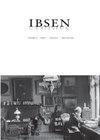The Dreams of A Spanish Patriot: Alfredo Marqueríe’s Fascist Version of Ibsen’s An Enemy of the People (1963)
IF 0.1
0 THEATER
引用次数: 0
Abstract
Shortly after the end of the Spanish Civil War (1936–1939), the widow of one of the introducers of Ibsen to the Spanish stage, Josep Maria Jord a, applied for a censorship approval for two of her husband’s Ibsen translations: Hedda Gabler and A Doll’s House. The first was prohibited on moral grounds, the second because it was in Catalan (AGA: Box 73/08262, File 1465/40 and File 1464/ 40). These were the first two Ibsen translations to be banned during Francisco Franco’s long dictatorship (1939–1975), several other would follow. Jord a, however, had engaged in yet another Ibsen play, namely An Enemy of the People, which he translated both into Spanish and Catalan. His widow never tried to get these translations approved, probably because, in the fin de si ecle period, the play had been popular among the left, and often staged by amateur groups linked to the labor movement (G omez-Baggethun 2020, 58–81, 99–103). In fact, the last time An Enemy of the People was produced in Spain before the Civil War was in 1920, when it was staged in Madrid on the occasion of the annual conference of the socialist trade union UGT. Although it is not surprising that Jord a’s widow was discouraged, she might have misjudged the situation. The truth is that An Enemy of the People never encountered any problems with the Francoist censorship. Although no one applied for a staging censorship approval of the play during the 1940s and 1950s, An Enemy of the People was frequently published during these two decades. And when the play finally returned to the西班牙爱国者的梦想:阿尔弗雷多·马奎尔的法西斯版易卜生的《人民的敌人》(1963)
西班牙内战结束后不久(1936年至1939年),易卜生在西班牙舞台上的介绍人之一Josep Maria Jord a的遗孀为她丈夫的两本易卜生译本《Hedda Gabler》和《玩偶之家》申请了审查批准。第一种是出于道德原因而被禁止的,第二种是因为它是在加泰罗尼亚语中(AGA:73/08262号信箱,1465/40号文件和1464/40号文件)。这是弗朗西斯科·佛朗哥长期独裁统治期间(1939年至1975年)被禁止的前两本易卜生译本,其他几本也将被禁止。然而,乔达参与了易卜生的另一部戏剧,即《人民的敌人》,他将其翻译成西班牙语和加泰罗尼亚语。他的遗孀从未试图让这些翻译获得批准,可能是因为在最后一个世纪,这部剧在左派中很受欢迎,而且经常由与劳工运动有关的业余团体上演(G omez Baggethun 2020,58-81,99-103)。事实上,《人民的敌人》上一次在西班牙内战前制作是在1920年,当时它在马德里举行的社会主义工会UGT年会上上演。虽然Jord a的遗孀气馁并不奇怪,但她可能误判了形势。事实是,《人民的敌人》从未遇到过法语审查制度的任何问题。尽管在20世纪40年代和50年代没有人申请该剧的舞台审查批准,但在这20年里,《人民的敌人》经常出版。当这出戏最终回到
本文章由计算机程序翻译,如有差异,请以英文原文为准。
求助全文
约1分钟内获得全文
求助全文

 求助内容:
求助内容: 应助结果提醒方式:
应助结果提醒方式:


